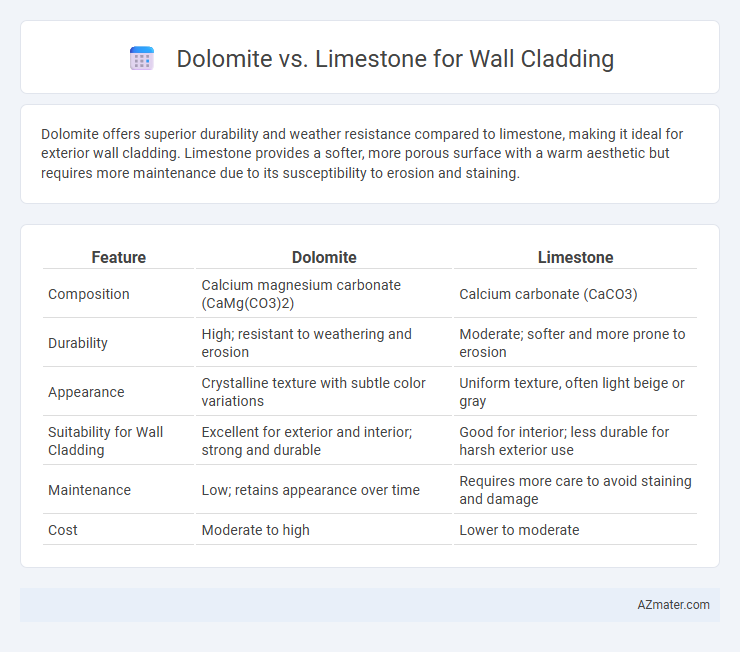Dolomite offers superior durability and weather resistance compared to limestone, making it ideal for exterior wall cladding. Limestone provides a softer, more porous surface with a warm aesthetic but requires more maintenance due to its susceptibility to erosion and staining.
Table of Comparison
| Feature | Dolomite | Limestone |
|---|---|---|
| Composition | Calcium magnesium carbonate (CaMg(CO3)2) | Calcium carbonate (CaCO3) |
| Durability | High; resistant to weathering and erosion | Moderate; softer and more prone to erosion |
| Appearance | Crystalline texture with subtle color variations | Uniform texture, often light beige or gray |
| Suitability for Wall Cladding | Excellent for exterior and interior; strong and durable | Good for interior; less durable for harsh exterior use |
| Maintenance | Low; retains appearance over time | Requires more care to avoid staining and damage |
| Cost | Moderate to high | Lower to moderate |
Introduction to Dolomite and Limestone
Dolomite is a sedimentary carbonate rock composed mainly of calcium magnesium carbonate, known for its hardness and resistance to weathering, making it a durable choice for wall cladding. Limestone, primarily consisting of calcium carbonate, offers a softer texture and more porous surface, which can enhance aesthetic appeal through varied finishes and patinas. Both materials provide unique structural and visual qualities, with dolomite favored for strength and limestone valued for its classic appearance in architectural applications.
Key Differences Between Dolomite and Limestone
Dolomite and limestone differ primarily in their chemical composition, with dolomite containing calcium magnesium carbonate (CaMg(CO3)2) and limestone composed mainly of calcium carbonate (CaCO3). Dolomite exhibits greater hardness and resistance to acid, making it more durable for wall cladding applications in harsh environments compared to the softer and more porous limestone. Moreover, the aesthetic variations in dolomite, often featuring a crystalline texture, contrast with the more uniform and fine-grained appearance of limestone, influencing design choices in architectural finishes.
Physical Appearance and Texture Comparison
Dolomite wall cladding exhibits a granular, crystalline texture with a subtle sparkle, offering a sleek and modern aesthetic. Limestone features a smoother, more uniform surface with natural fossils and sediment layers, providing a classic and rustic appearance. The denser composition of dolomite results in a harder, more durable cladding compared to the softer, more porous texture of limestone.
Durability and Strength Analysis
Dolomite exhibits higher compressive strength and greater resistance to weathering compared to limestone, making it a more durable option for wall cladding in harsh environments. Limestone, while aesthetically appealing, tends to be softer and more porous, leading to increased susceptibility to erosion and surface damage over time. Selecting dolomite enhances structural integrity and longevity in cladding applications exposed to variable climatic conditions.
Water Absorption and Weather Resistance
Dolomite exhibits lower water absorption rates compared to limestone, enhancing its durability in wall cladding applications exposed to moisture. Its dense crystalline structure provides superior resistance to weathering, making it ideal for harsh environmental conditions. Limestone, while aesthetically versatile, tends to absorb more water, which can lead to increased erosion and reduced longevity in exterior cladding installations.
Color Options and Aesthetic Appeal
Dolomite offers a broader range of color options for wall cladding, including shades of white, gray, pink, and even green hues, enhancing its versatility in aesthetic design. Limestone typically presents softer, more neutral tones like beige, cream, and light gray, lending a classic and timeless appeal to interiors and exteriors. The choice between Dolomite and Limestone influences the visual impact of a space, with Dolomite providing more vibrant and varied color palettes, while Limestone ensures subtle elegance.
Installation Process for Wall Cladding
Dolomite wall cladding requires precise cutting and handling due to its hardness, often demanding specialized tools and skilled labor to ensure a smooth finish and secure fit. Limestone, being softer, allows for easier shaping and installation with standard equipment, reducing labor time and costs. Both materials need proper sealing to prevent moisture damage, but limestone's porous nature typically requires more frequent maintenance after installation.
Maintenance Requirements for Each Material
Dolomite wall cladding requires minimal maintenance due to its high resistance to weathering and chemical erosion, making it ideal for exterior applications exposed to harsh conditions. Limestone, while aesthetically pleasing, demands more frequent sealing and cleaning to prevent staining and erosion, especially in acidic or polluted environments. Regular inspection and prompt repair of any surface damage are essential for both materials to ensure long-term durability and appearance.
Cost Considerations and Budgeting
Dolomite typically costs more than limestone due to its higher density and durability, making it a long-term investment for wall cladding projects. Limestone offers a more budget-friendly option with easier workability and lower installation expenses, suitable for cost-sensitive applications. When budgeting, consider the lifecycle cost differences, including maintenance and replacement frequency, to determine the most economical choice for your wall cladding needs.
Sustainability and Environmental Impact
Dolomite and limestone both offer eco-friendly options for wall cladding due to their natural origin and durability, reducing the need for frequent replacements. Dolomite has a slightly higher resistance to weathering, which can extend the lifespan of cladding projects and minimize environmental waste over time. Limestone typically requires less energy-intensive processing, lowering its carbon footprint compared to some alternative building materials.

Infographic: Dolomite vs Limestone for Wall Cladding
 azmater.com
azmater.com